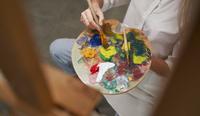Art Therapy Activities PDF for Anxiety and PTSD

Art therapy can promote engagement in clients resistant to traditional therapy interventions. This art therapy activities PDF list includes art therapy activities for anxiety and PTSD group therapy activities that can help inspire you with new ideas.
In this article, we’ll go over art therapy activities for anxiety and post-traumatic stress disorder (PTSD)—providing art therapy prompts that can be used in individual therapy as well as PTSD group therapy activities.
This art therapy activities PDF includes a list of activities suitable for both adults and teens, with slight variations depending on the age of the participants.
You can use these activities at the start of counseling as a general way to build rapport. They can also be used over the course of counseling to treat certain conditions, such as anxiety and PTSD, or teach coping mechanisms like mindfulness through mindfulness art therapy activities.
Read on for ideas on what to include in your art therapy activities PDF and how to incorporate art therapy into your practice.
Art therapy activities for all ages
Art therapy activities can be beneficial for children, teens, and adult clients. Here are some art exercises we’ve included in our art therapy activities PDF that I’ve found most helpful when treating clients of all ages.
Follow the directions for the art therapy activities below to facilitate treatment plans and goals for clients who need art therapy activities for anxiety or PTSD.
Art therapy activities for teens
Dot Mandala Stones
- Choose three to five smooth stones, small enough to fit into the palm of your hand.
- Lay out paper towels and 3D puffy paint.
- Tell the teen to create a mandala pattern using dots of puffy paint. Explain to them that once dry, the raised dots will add a physical grounding effect.
- Tell them to keep the stone in their pocket to feel whenever they feel stressed.
Emotion Color Swatches
- Gather three to five paint color swatches from a hardware store, with at least three different shades on each swatch.
- Discuss with the teen how emotions come in various stages and intensities (i.e., anger can present as frustrated, annoyed, or irate).
- Provide a list of feeling words and ask them to select the words that most often represent their own feelings.
- Tell the teen to write those feelings in order of severity on the paint swatches, from lightest (least severe) to darkest (most severe).
- Punch a hole in the swatches and attach them to a ring.
- Encourage the teen to think of their emotions in colors to help them better identify and communicate how they’re feeling.
Check out our additional information on Art Therapy Activities for Teenagers and Group Therapy Activities for Kids and Teenagers to learn more on how to help your teen clients through art therapy.
Art therapy activities for adults
Life as I See It
- Give your client construction paper and colored pencils.
- Explain how counseling can help us thoughtfully and objectively evaluate life problems.
- Direct your client to fold their paper in half lengthwise and then again horizontally.
- When they unfold the paper, tell them to draw an image on each square, representing a current problem they’d like to address in counseling.
- Allow 10 to 15 minutes for drawing.
- Then, provide your client with discussion prompts. For example, ask them: What problems did you identify? How long have they been problems for you? What have you done to address them?
- Ask the order in which they want to address these problems in counseling and write that number in the corner of each picture.
- Save this drawing in your client’s file and use the information for treatment planning and updates.
- Periodically reproduce the drawing and ask your client to reevaluate the life problems represented.
Timeline
- Provide your client with a large sheet of butcher paper, paint, brushes, and pens.
- Tape the paper to a table and tell your client to make a timeline of their life.
- Ask them to write the current year and their birth year, then write memorable years in between along a line across the bottom of the paper.
- Tell your client to paint different colors for each year according to what occurred (i.e., a client who graduated high school and whose pet died in the same year may paint yellow and black above that year to represent happiness and grief, respectively).
- Give your client 20-30 minutes to finish their timeline and then offer prompts for discussion such as: What was it like for you to reflect on your life? What years did you choose and why? What colors did you choose and what do they symbolize? What colors do you want to paint in this year and what will they symbolize?
Art therapy activities for anxiety
Safe Place Collage
- Offer scrapbook paper with plastic sheets, scissors, glue, tape, various magazines, and markers to your client.
- Discuss the value of referencing an actual picture when we use positive imagery to manage anxiety.
- Tell your client to create two collages using images from the magazines that they find pleasant..
- Allow 20-30 minutes for the activity.
- Then, ask questions regarding the usefulness of their collages: What’s calming about these pictures? How does your mood change when you think about them? How can they help you overcome anxiety?
- Encourage your client to keep the two collages they made in separate locations for easy access, like their nightstand or a desk drawer.
Anxiety Cartoons
- Supply your client with computer paper and colored pencils.
- Explain how anxiety is usually internalized—we often don’t want to talk about it or feel we cannot, talk about it— which actually intensifies its symptoms.
- Help your client talk more openly by creating a visual representation of anxiety.
- Tell your client to personify anxiety, imagining anxiety as an actual being with visual and physical characteristics, and a personality of its own.
- Ask them what anxiety looks like and how anxiety behaves.
- Encourage them to draw anxiety in as much detail as possible—give them 10-15 minutes to complete the picture and written description.
- Then, share these art therapy prompts for discussion: What do you notice about anxiety in picture-form? Do you spot any of its strengths or weaknesses? How did it originate? What makes it stick around? What will make it go away?
Mindfulness art therapy activities to cope with anxiety
Beading
- Give your client various beads and charms, elastic cord, tacky glue, and a small tray to work in.
- Explain how beading helps us focus on the present as we select which beads to use, string them, and count them. Instruct clients to make a bracelet, necklace, keychains, or whatever item they would like.
- Let them know that they can run their fingers over the beads when they feel anxious to calm down.
- Guide your client in making at least two items using the materials provided.
- Afterwards, ask your client the following questions: What made you choose those beads or charms? How did you feel while completing this activity? How helpful would it be for you to do this on your own at home?
Finger Painting
- Provide your client with water-based paints, canvas, and hand wipes or towels. As a back-up, keep paint brushes or sponges on hand.
- Explain how feeling different textures and temperatures can redirect our attention to the here-and-now. Finger painting has this effect as we notice the coolness of paint on our skin, and the sensation as we move our fingers across the bumpy canvas.
- Encourage your client to join in this childhood pastime—offering them the back-up brushes and sponges, if needed. Clients who are averse to getting their hands dirty may still be able to experience the textural differences between using two different painting tools, like brushes and sponges.
- Ask questions throughout the activity such as: How did the paint feel on your hands? How did the canvas feel? What were you thinking about as you painted?
These art therapy activities for anxiety are a great way to help clients de-stress in the moment. You can also download our Free Anxiety Coping Worksheets.
Art therapy PTSD activities
Since avoidance is often a hallmark symptom of PTSD, clients struggling with this issue are unlikely to discuss details of their traumas before building solid rapport. The foundations of your relationship need to be built over multiple sessions in which your client is allowed to relax and settle in.
Coloring can satisfy this purpose, as your client is given a picture to focus on and freedom to use whatever colors they choose. Follow the directions in these art therapy activities for PTSD.
Coloring Pages
- Present your client with pages from a coloring book, along with colored pencils, crayons, or markers. This activity can be done with adults, as well as teens and children.
- Ask your client if they prefer background music or silence as they color.
- Join your client in coloring your own pages and, when appropriate, offer prompts: When was the last time you colored? What do you like/dislike about coloring? Do you feel any different since before you started coloring? How can coloring help you manage your PTSD symptoms?
Past, Present, Future
- Give your client construction paper, colored pencils, and pens.
- Guide them in making a trifold (it will look like a brochure), then instruct them to unfold and flatten it.
- Explain how PTSD directly affects our attitude toward life.
- Tell your client to write “Past, Present, Future” at the top of each rectangle on their paper.
- Ask them to draw themselves in each category, showing how post-traumatic stress has affected their attitude toward each time frame of their life.
- Allow time for your client to explain their drawings and process them.
- Then, ask questions such as: What were you like before the trauma? How are you now because of it? How do you see your future self affected by PTSD?
PTSD group therapy activities
How I See Myself/How Others See Me Portraits
- Provide your group with paper and colored pencils.
- Direct members to draw two portraits: one showing how they view themselves, and one showing how they think others see them.
- Allow 15-20 minutes for clients to complete the activity.
- Then, ask members to share their portraits.
- Offer discussion prompts for individual feedback such as: How are your portraits alike or different? How does trauma affect these pictures?
- Then, offer discussion prompts for the group’s response: Is this an accurate representation? What’s a positive attribute that was left out?
This activity is a way to integrate cognitive behavioral therapy (CBT) exercises in a group therapy setting.
Heart Inventory
- Give your group paper, colored pencils, and lists of emotions. This Child Anger Management Worksheet has an emotions list you can download for free.
- Tell members to write any emotions they experience when reminded of their trauma, and list them in a legend on the corner of their paper.
- Next, ask them to assign a different color to each emotion and draw a large heart in the middle of their paper.
- Direct your group to color their heart according to the intensity and prevalence of each emotion and traumatic event it relates to.
- Allow 10-15 minutes for members to complete their drawings, then ask them to share them with the group.
- Offer prompts as appropriate, such as: Is this a typical, daily representation of what you feel? What would your inventory look like if the trauma hadn’t occurred? How can the negative emotions be replaced or lessened by positive ones?
- At the end of the session, emphasize how drawing heart inventories can be helpful for our end-of-day reflections to measure our progress in managing post-traumatic stress.
If you run a lot of group therapy sessions, and you want more ideas for your art therapy activities PDF, check out our articles on Group Therapy Activities for Adults as well as Group Therapy Activities for Kids and Teenagers.
How SimplePractice streamlines running your practice
SimplePractice is HIPAA-compliant practice management software with everything you need to run your practice built into the platform—from booking and scheduling to insurance and client billing.
If you’ve been considering switching to an EHR system, SimplePractice empowers you to run a fully paperless practice—so you get more time for the things that matter most to you.
Try SimplePractice free for 30 days. No credit card required.
More Stories
Stay inspired
Get the latest stories from your peers right to your inbox.










